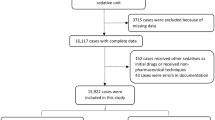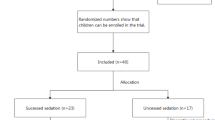Abstract
Preschoolers frequently require sedation for echocardiograms. This study compared various sedation drugs at the authors’ institution, as well as the charges for moderate versus deep sedation. From 2001 to 2007, sedation was administered to 703 patients ages 2 to 4 years. Four drug regimens were used: chloral hydrate (CH), chloral hydrate with diphenhydramine (CH + D), chloral hydrate with hydroxyzine hydrochloride (CH + H), and midazolam. The mean onset of sedation was 37 min, and the mean duration of sedation was 47 min. The CH group fell asleep the most quickly (30 min; p < 0.001), and the CH + D patients experienced the most prolonged sedations (13%; p < 0.001). Studies were completed by 97% of the chloral hydrate group, 98% of the CH + D group, and 94% of the CH + H group compared with 66% of the midazolam group (p < 0.001). Complications (7.4%) were minor and not significant for any particular medication. The charges for moderate sedation averaged $709 compared with $3,628 for deep sedation. The findings demonstrated that chloral hydrate was the fastest-acting agent and had a high success rate with minimally prolonged sedations. The low complication rate for chloral hydrate, and the much lower cost for its use to induce moderate sedation have made chloral hydrate our preference for the echocardiographic sedation of preschoolers.
Similar content being viewed by others
References
Task Force of the Pediatric Council of the American Society of Echocardiography (2006) Guidelines and standards for performance of a pediatric echocardiogram. J Am Soc Echocardiogr 19:1413–1430
Buck ML (2005) The use of chloral hydrate in infants and children. Pediatr Pharm 11(9):1–4
D’Agostino J, Terndrup TE (2000) Chloral hydrate versus midazolam for sedation of children for neuroimaging: a randomized clinical trial. Pediatr Emerg Care 16:1–4
Kohli V (2000) Sedation for pediatric echocardiography: a brief review. Heart Views 1:314–316
Napoli KL, Ingall CG, Martin GR (1996) Safety and efficacy of chloral hydrate sedation in children undergoing echocardiography. J Pediatr 129:287–291
Wheeler DS, Jensen RA, Poss WB (2001) A randomized, blinded comparison of chloral hydrate and midazolam sedation in children undergoing echocardiography. Clin Pediatr 40:381–387
Sheroan MM, Dilley DC, Lucas WJ, Vann WF (2006) A prospective study of 2 sedation regimens in children: chloral hydrate, meperidine, and hydroxyzine versus midazolam, meperidine, and hydroxyzine. Anesth Prog 53:83–90
Torres-Perez J, Tapia-Garcia I, Roasales-Berber MA, Hernandez-Sierra JF, Pozos-Guillen AJ (2007) Comparison of three conscious sedation regimens for pediatric dental patients. J Clin Pediatr Dent 31:183–186
Child Development Institute, LLC. General developmental sequence, toddler through preschool. www.childdevelopmentinfo.com/development/devsequences.html. Accessed 25 May 2009
Academy of Pediatrics, American Academy of Pediatric Dentistry, Cote C, Wilson S, the Working Group on Sedation (2006) Guidelines for monitoring and management of pediatric patients during and after sedation for diagnostic and therapeutic procedures: an update. Pediatrics 118:2587–2602
Malviya S, Voepel-Lewis T, Tait AR, Merkel S, Tremper K, Naughton N (2002) Depth of sedation in children undergoing computed tomography: validity and reliability of the University of Michigan sedation scale (UMSS). Br J Anaesth 88:241–245
Istaphanous GK, Loepke AW (2009) General anesthetics and the developing brain. Curr Opin Anaesthesiol 22:368–373
Young TE, Mangum B (2007) Neofax: a manual of drugs used in neonatal care, 20th edn. Thompson Healthcare, Montvale, NJ, p 163
Lazol JP, DeGroff CG (2009) Minimal sedation second-dose strategy with intranasal midazolam in an outpatient pediatric echocardiographic setting. J Am Soc Echocardiogr 22:383–387
Heistein LC, Ramaciotti C, Scott WA, Coursey M, Sheeran PW, Lemier MS (2006) Chloral hydrate sedation for pediatric echocardiography: physiologic responses, adverse events, and risk factors. Pediatrics 117:e434–e441
Roach CL, Husain N, Garg R, Welch E (2009, spring newsletter) Summary of an online survey: re: sedation for echocardiography in preschoolers. Society of Pediatric Cardiovascular Nursing, St. Petersburg, FL
Author information
Authors and Affiliations
Corresponding author
Rights and permissions
About this article
Cite this article
Roach, C.L., Husain, N., Zabinsky, J. et al. Moderate Sedation for Echocardiography of Preschoolers. Pediatr Cardiol 31, 469–473 (2010). https://doi.org/10.1007/s00246-009-9622-z
Received:
Accepted:
Published:
Issue Date:
DOI: https://doi.org/10.1007/s00246-009-9622-z




